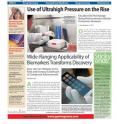GEN reports on rediscovered technology to bolster proteomics research
Scientists are turning to a decades-old technique to better understand the physical effects of compression on macromolecules and how it might impact their research in proteomics, mass spectrometry, protein extraction, and tissue investigations, reports Genetic Engineering & Biotechnology News (GEN). These studies are built upon the early ultrahigh pressure discoveries of the late Nobel Prize winner in Physics, Percy Bridgman, Ph.D., who was a professor at Harvard from 1908 to 1954, according to the August issue of GEN (http://www.genengnews.com/gen-articles/use-of-ultrahigh-pressure-on-the-rise/3360). "Pressure-cycling technology (PCT) has definitely caught the attention of an increasing number of scientists," says John Sterling, Editor in Chief of GEN. "In addition, researchers no longer need to construct their own tools because instruments such as the Barocycler® from Pressure Biosciences are now available."
Zoltan Szabo, Ph.D., senior research scientist at the Barnett Institute at Northeastern University, relies on PCT for glycan analysis. Glycans are ordinarily N-linked and are evaluated using capillary electrophoresis and liquid chromatography. Dr. Szabo and his colleagues, however, used PCT to accelerate N-linked glycan release by peptides using the enzyme N-Glycosidase F, also known as PNGase F.
Membrane proteins represent one of the most appealing targets for cancer detection and therapy. But the extraction of proteins from membranes is complex and challenging, given the inculcation of the proteins throughout a tenacious lipid bilayer. For this reason, Luke Schneider, Ph.D., CSO, Target Discovery, and his co-workers have applied PCT to the extraction of membrane proteins from ovarian cancer tissues.
Source: Mary Ann Liebert, Inc./Genetic Engineering News
Other sources
- GEN reports on rediscovered technology to bolster proteomics researchfrom Science BlogFri, 13 Aug 2010, 19:56:08 UTC
